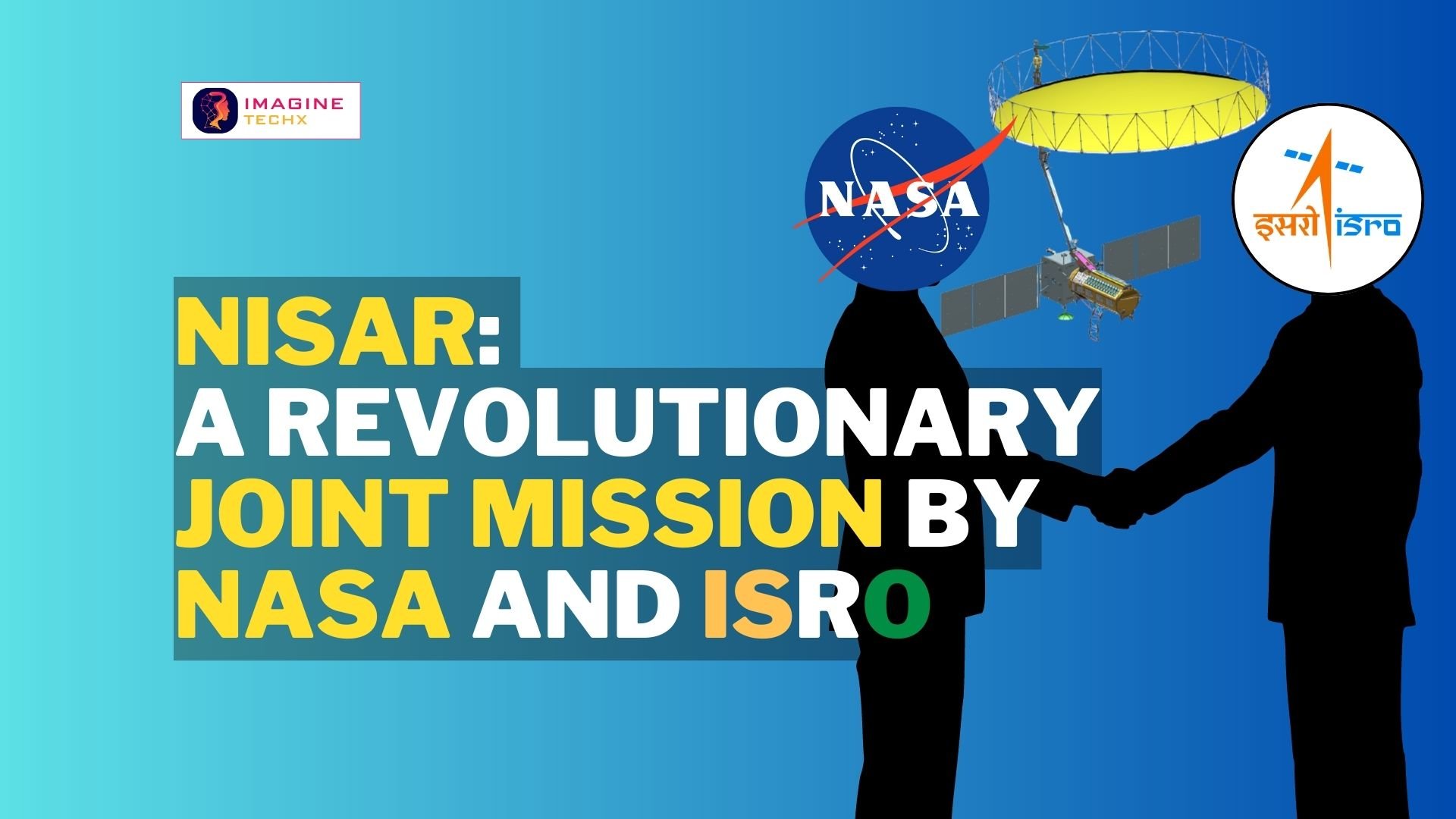NISAR: A Revolutionary Joint Mission by NASA and ISRO

A Revolutionary Joint Mission by NASA and ISRO
Introduction Of NISAR: A Revolutionary Joint Mission by NASA and ISRO:
In the vast expanse of space, two giants of space exploration have come together to create something truly extraordinary – the NASA–ISRO SAR (NISAR) mission. This Low Earth Orbit (LEO) observatory, jointly developed by NASA and the Indian Space Research Organisation (ISRO), promises to revolutionize our understanding of our planet’s dynamic processes. NISAR is set to become a game-changer in monitoring and studying Earth’s ecosystems, ice masses, vegetation, sea level rise, groundwater, and natural hazards. In this blog, we will delve into the fascinating details of NISAR, its mission objectives, technology, and the profound impact it will have on our understanding of Earth.
Understanding the Mission:
At the heart of the NISAR mission is a remarkable goal – to map the entire globe in just 12 days. This ambitious objective is made possible through cutting-edge technology, primarily the L and S dual-band Synthetic Aperture Radar (SAR). This radar operates using the Sweep SAR technique, enabling it to capture vast swaths of the Earth’s surface with remarkable resolution. The SAR payloads, mounted on the Integrated Radar Instrument Structure (IRIS) and the spacecraft bus, together form the NISAR observatory.
You Can Read This Post Also:
Exploring the Cosmic Mysteries with India’s XPoSat: A Pioneer in X-ray Polarimetry
A Partnership of Giants:
The collaboration between NASA and ISRO in creating NISAR is a testament to international cooperation in the realm of space exploration. Both agencies bring their unique expertise to the table. NASA is responsible for the L-Band SAR payload system, while ISRO supplies the S-Band SAR payload. Additionally, NASA contributes vital engineering payloads, including a Payload Data Subsystem, High-rate Science Downlink System, GPS receivers, and a Solid State Recorder. This partnership exemplifies the fusion of two cultures and the work of two sets of craftsmen in crafting something truly exceptional.
A Technological Marvel:
NISAR is set to make history as the first dual-frequency radar imaging mission in L-Band and S-Band. The advanced Sweep SAR technique employed by NISAR promises high-resolution data with a large swath. This capability is crucial for studying a wide range of Earth phenomena, from ecosystem disturbances to ice sheet collapses and natural disasters such as earthquakes, tsunamis, volcanoes, and landslides.
Unlocking Earth’s Mysteries:
One of the most exciting aspects of NISAR is its potential to unravel some of Earth’s most complex and pressing mysteries. The precision interferometric orbits of the mission will enable the mapping of minute deformations in the Earth’s surface, down to a few millimeters. This level of detail is invaluable for understanding solid Earth processes and phenomena.
Monitoring Our Environment:
NISAR’s selection of lower frequency bands, L-Band and S-Band, offers unique advantages. These frequencies penetrate vegetation and can provide crucial insights into the Earth’s carbon stock estimation and carbon fluxes from vegetation. Moreover, they enable the observation of targets beneath tree canopies and sub-surface features. These capabilities are instrumental in comprehensively monitoring our environment.
Applications Beyond Borders:
NISAR’s applications extend far beyond its creators’ national boundaries. The observatory will acquire data over the Indian coasts, monitoring annual changes in the bathymetry along deltaic regions. It will also keep a watchful eye on the shoreline, erosion, and accretion. Over the seas surrounding India’s Antarctic polar stations, NISAR will observe sea ice characteristics, making it invaluable for detecting marine oil spills and taking preventive measures during accidental oil seepage.
The Engineering Marvel Behind NISAR:
The NISAR observatory boasts a remarkable 12-meter wide deployable mesh reflector, mounted on a deployable 9-meter boom developed by NASA’s Jet Propulsion Laboratory (JPL). This reflector is shared by both the L-Band SAR payload system developed by JPL-NASA and the S-Band SAR payload developed by ISRO. The IRIS plays a crucial role in hosting the SAR tiles along with their electronics and data handling systems. The spacecraft itself incorporates all the essential elements for attitude and orbit control, power systems, and thermal management.
The Journey of NISAR:
NISAR’s development occurs in three distinct phases. The SIT-2 phase focuses on independently developing the SAR payloads and the engineering systems. In the SIT-3 phase, these payloads, along with other related systems, are integrated into the Radar Instrument Structure and tested at JPL. Concurrently, ISRO works on spacecraft systems realization and testing. The final phase, SIT-4, involves integrating IRIS with the spacecraft and evaluating it as an observatory. This phase is currently underway and is critical as it involves the performance evaluation of the entire observatory.
The Countdown to Launch:
Excitement is building as the NISAR observatory is set to be launched from Indian soil in the first quarter of 2024. The GSLV expendable launch vehicle, provided by ISRO, will carry this remarkable piece of technology into space. The target launch readiness date is January 2024, and the entire launch sequence is a critical event.
Commissioning for Science:
The period immediately following launch is dedicated to commissioning, or in-orbit checkout (IOC). This crucial phase spans the first 90 days and involves preparing the observatory for science operations. Commissioning is divided into several sub-phases, including initial checkout of engineering systems and payload, spacecraft checkout, and instrument checkout. This step-by-step approach ensures that all systems are functioning optimally before commencing scientific observations.
Embarking on Science Operations:
After the commissioning phase, the NISAR observatory enters its science operations phase, which lasts for three years. During this time, the observatory will collect the data needed to achieve its Level 1 science objectives. This phase includes regular maneuvers to maintain the science orbit, calibration and validation activities, and extensive data collection.
The Power of Collaboration:
The success of NISAR hinges on the collaboration between NASA and ISRO, two organizations with a history of pushing the boundaries of space exploration. Their shared vision and expertise have resulted in a mission that promises to transform our understanding of Earth’s complex systems.
You Can Read This Post Also:
Conclusion:
In conclusion, the NASA-ISRO SAR (NISAR) mission represents a remarkable fusion of technology, expertise, and international cooperation. With its advanced radar technology, NISAR will provide unprecedented insights into Earth’s dynamic processes, from ecosystem changes to natural disasters. As we eagerly await its launch in early 2024, the scientific community and the world at large can look forward to a new era of understanding our planet’s intricate systems, all thanks to the collaborative efforts of NASA and ISRO. NISAR truly embodies the spirit of exploration and discovery that drives humanity’s quest to unravel the mysteries of our home planet.






